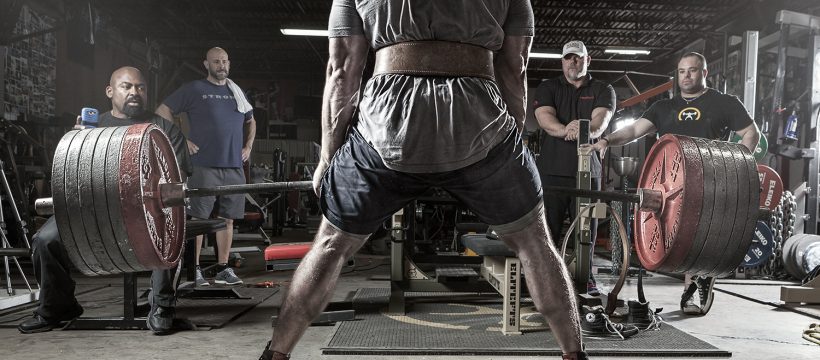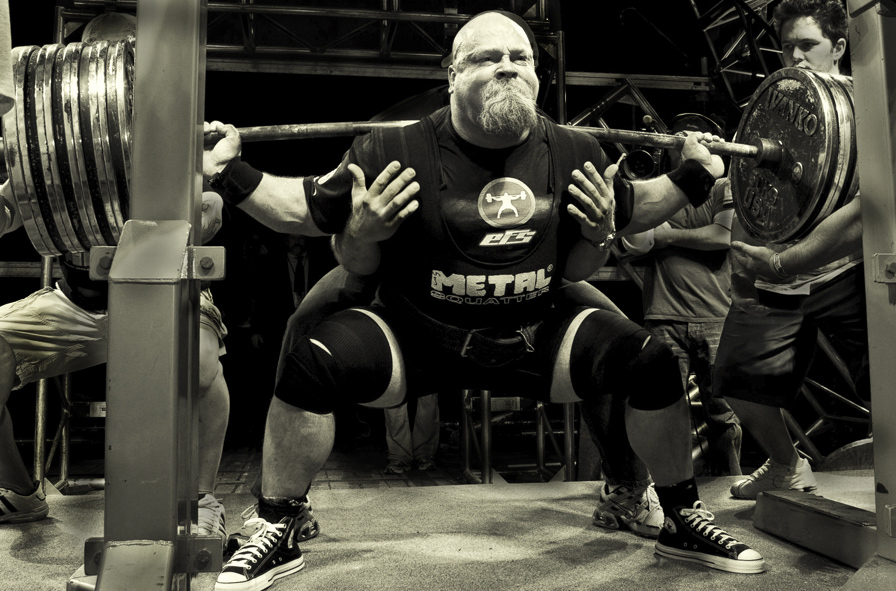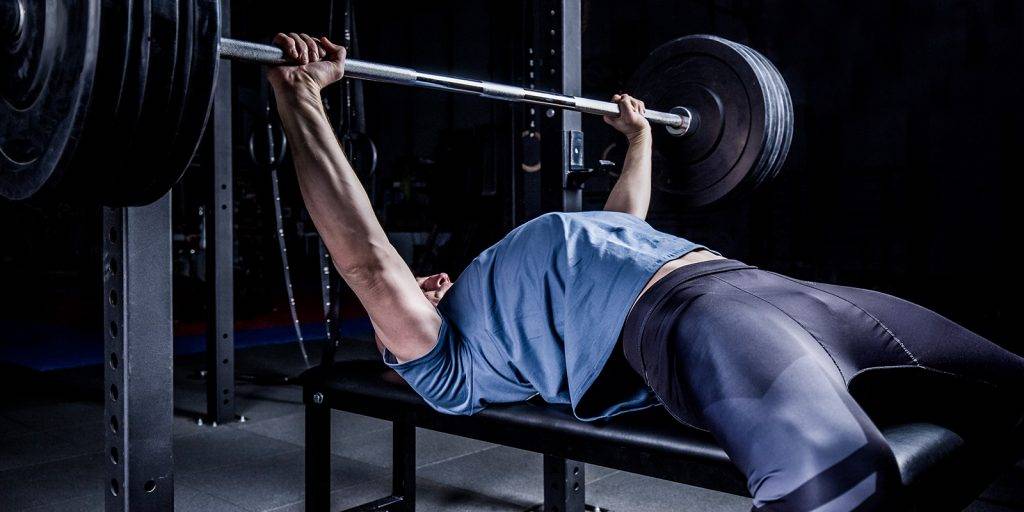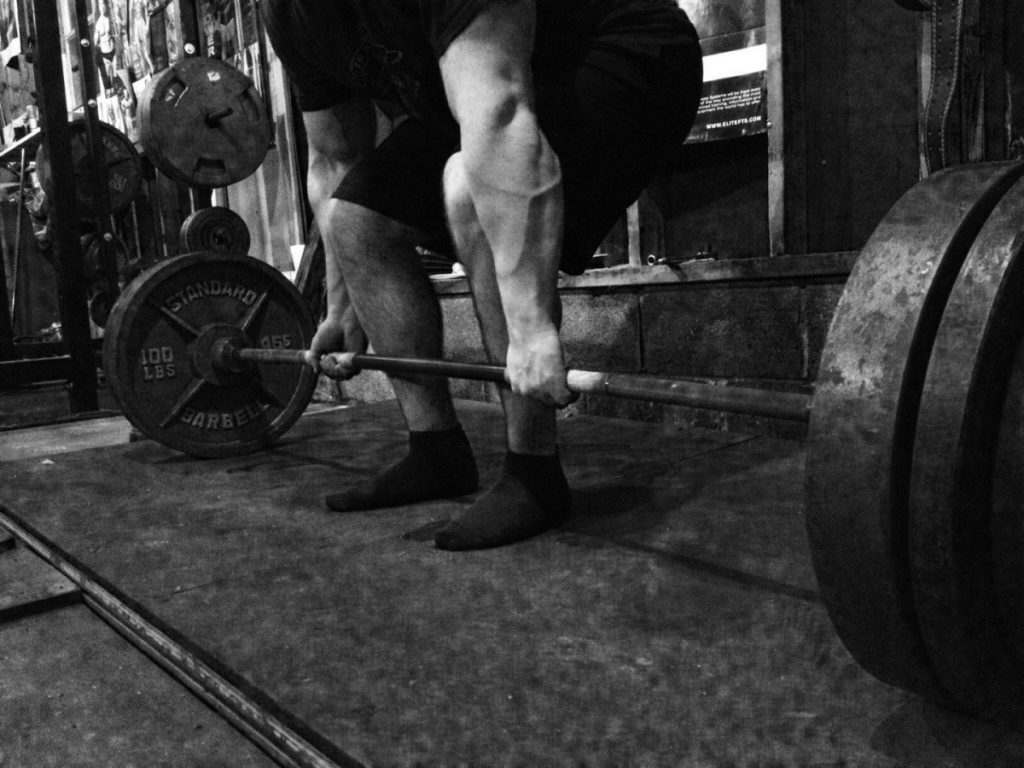So, you’ve taken an interest in how you look? Bigger arms, beefy chest and boulder shoulders attract girls don’t they? MMMmmm, well, you have gone down to the local fitness-a-rama and signed up on a 12 month contract, the in-house personal fitness instructor has given you a routine to follow and you crack on, three times a week hitting the pec dec , tri kickbacks and ab crunch, then you notice a fella in the corner, he seems to be just lifting a lot of weight, up off the floor, then back down ….someone said he has just competed in something …. what the hell is he doing? It looks interesting; I might go over and have a chat…
…welcome son, you’re about to enter the world of powerlifting!
Powerlifting is a strength sport, with three events: the squat, bench press and deadlift.
The maximum weight lifted in each event is totalled for a final score (each lifter gets 3 attempts at each of the 3 events – 9 lifts per competition). Lifters compete in bodyweight and age classes, along these lines: under 75kg, 75-82.5kg, 82.5kg-90kg, 90kg-100kg, 100kg-110kg, 110kg-125kg, 125kg-140kg, 140kg+ although there are lighter weight classes, especially for women competitors, and also classes may differ depending on which federation you lift in.
There are many powerlifting federations, with the main ones in the UK being BWLA, BDFPL ,BPC and BPO. BWLA and BDFPA are both ‘tested’ federations and will carry out random drug tests, but in practice this doesn’t happen as often as they would like due to the cost of testing. The BPC and BPO are non-tested federations. All federations allow the use of equipment to a different degree. The age classes are usually T1/T2/T3 for teens, juniors are 18-23, senior 24-40, masters 1 (M1) 40-50M2 (50-60), M3 (60-70) and M4 (70-80), these can vary a little depending on which federation you compete in.
The three powerlifting events:
Squat
The racked barbell is loaded with the weight desired. The competitor positions themselves so that the bar is resting across the trapezius muscles, with an overhand wide grip to help stabilise the bar. The barbell is un-racked and the competitor steps clear of the racking equipment, unless in the BCP/BPO federation where a monolift is used.
The competitor squats down to a depth where the thigh at the hip joint is below the level of the top of the knee. The competitor then ascends back to starting position to re-rack the bar. The competitor must not make any downward motion once the ascend begins, they should also re-rack the weight under their own power with no help, and have no aid from spotters in any way during the discipline.
If the competitor successfully performs the lift under the above guidelines then it should usually be deemed and called a good lift.
Bench press
The barbell is loaded with the desired weight, and is racked in the supports on the stands on the bench. The competitor lies supine on the bench, grasps the barbell and un-racks the barbell with the aid of spotter/s. The barbell is fully extended above the competitor so a full descend is required. The competitor lowers the barbell under their own control, to the chest, then presses the bar back up to lock out of the arms through the ascend phrase (without touching the uprights of the rack). The competitor must not pause at the bottom of the movement when the barbell makes contact with the competitor, and a ‘press’ command is usually called by the judge to overcome this.
There is some variation between federations on how low the bar is placed on the body at the bottom of the movement. There must be no downward motion during the ascend phrase of the discipline, not should the competitor make any movements with their feet, take their buttocks off the bench, or make any aiding bodily movements during the lift.
If the competitor successfully performs the lift under the above guidelines then it should usually be deemed and called a good lift.
Deadlift
The barbell is loaded with the desired amount of weight, and is placed on the floor. The competitor squats down and grasps the barbell, with their feet placed under the bar for better balance with the execution. The competitor ascends whilst gripping the barbell, until they are completely upright with the chest out and up, knees locked out with a balanced posture, known as lock out. The competitor then descends under control so the bar lowers to the floor, usually after the call of the judge after the competitor successfully locks out with the weight.
The competitor must not hitch the weight, where the thighs are used during the discipline to help aid the lift, nor should they make any downward motion during the ascend. No lift can be called if the competitor drops or doesn’t control the bar back to the floor after lock-out.
The barbell is loaded with the desired weight, and is racked in the supports on the stands on the bench. The competitor lies supine on the bench, grasps the barbell and un-racks the barbell with the aid of spotter/s. The barbell is fully extended above the competitor so a full descend is required. The competitor lowers the barbell under their own control, to the chest, then presses the bar back up to lock out of the arms through the ascend phrase (without touching the uprights of the rack). The competitor must not pause at the bottom of the movement when the barbell makes contact with the competitor, and a ‘press’ command is usually called by the judge to overcome this.
There is some variation between federations on how low the bar is placed on the body at the bottom of the movement. There must be no downward motion during the ascend phrase of the discipline, not should the competitor make any movements with their feet, take their buttocks off the bench, or make any aiding bodily movements during the lift. If the competitor successfully performs the lift under the above guidelines then it should usually be deemed and called a good lift.
That’s the three events in powerlifting. Now let’s look at “equipment”.
Equipment
‘Equipped lifting’ is where the lifter will wear clothing to aid his/her lifts. It is often misunderstood that this makes it easier, far from it, lifting equipped is mentally very demanding. Knee wraps, squat suit, bench press shirt and deadlift suit can all be used in an equipped meet – some federations allow ‘double ply’suits/shirts which is basically two suits made as one, this allows greater support and therefore potentially more weight lifted. Knee wraps are a good place to start – fairly cheap and they give you an idea of how much support and ‘ping’ out of the hole during the squat that equipment can give. The least used piece of equipment would be the deadlift suit as the ‘carry over’ or amount ONTOP on the raw lift is minimal. Some fed also allow briefs which are basically shorts made from the same material as the squat suit, which offer even more support if worn under the suit, however this is usually only reserved for elite/advanced lifters only.
I would advise a beginner to lift RAW for a while as this will build a solid base of core strength.
BWLA & BDFPA will allow single ply suits and 2 metre knee wraps
BPC allows double ply suits and double ply briefs along with 2.5metre knee wraps
BPO allows the use of single ply suits and briefs and 2.5metre knee wraps
Whether you bench 40kg’s or 240kg’s , squat 60kg’s or 600lb’s, it’s important to get the form right – many lifters train on their own and it’s not until they visit a powerlifting gym that their poor form is pointed out. It is difficult to rectify without costing kg from your max lifts, so if you do have an interest – search out a club in your area and go along, you won’t regret it.



